View current page
...more recent posts
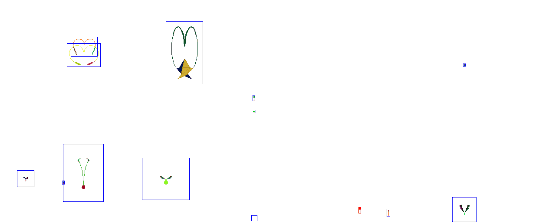
Another blog-sized Petra Cortright capture. This work would be really great on a big plasma screen. Just kidding!
"Bass Iterator 2" [mp3 removed]
Done a couple of years ago but never posted (I chose another version). It's more in the art-techno genre before I started caring about musical structure. The "iterations" are all timbral--the notes don't change.
Michael Bell-Smith, "Video Created to Fix Stuck Pixels in Computer Monitors Recast (with Soundtrack and Sunset) as Video to Fix Your Stuck Mind" (link to Quicktime .mov here ). This was posted a while back but I missed it (thanks, paul). Very amusing--excellent title.

Petra Cortright: from Selected System Landscapes:
10
18
Karl Blossfeldt meets Tron by way of pixel art. The image above is a "remix"--apologies to the artist, just wanted something self contained and looping for the blog since most of imagery fills the entire screen. You can page through the presentation, which is somewhat JODI-esque but with more of the cool botanical imagery--by clicking anywhere on the screen. Just singling out a couple of pages I like--for the busy surfer.
"Enigmatic Rap (Piano Version)" [mp3 removed]
Somewhat inspired by a piano rendition of Gary Numan's "Are 'Friends' Electric?" I heard a while back, but without the emo vocals that came with it.
For those who might've lost interest or faith in Lost (new watchers, never mind, you'll never get up to speed): the series suddenly rocks anew. A deft exercise in Tarantino-esque narrative manipulation, last night's installment "Exposé" recapped three seasons of the show through the POV of two minor, expendable characters, including a revisitation of the infamous pilot episode's "crash on the beach." (Which means the producers shot footage from that expensive opening for use many shows later in the story arc? Seems so.) What critic tedg calls "folding" abounds--one of the expendable characters guest-stars in a TV trash series called Exposé, a clip of which is seen at the beginning of her back story, an equally trash noir tale of a jewel heist she pulls off with another island crash survivor, all framed within Lost's own Survivors vs Others uber-narrative and climaxing with a macabre, Poe-like ending. Russian toy dolls-within-dolls that figure prominently in the story mimic the nested plots. Humorously, only the comic relief character Hurley has actually watched Exposé, but loves it.
Last week's show, "The Man From Tallahassee," also a keeper, featured flashbacks--finally--explaining how John Locke got in the wheelchair he mysteriously no longer needs. One wishes the writers would cut the poor bastard a break--the scheming cult leader Ben Linus (Torwald) immediately undermines Locke's moment of decisive heroism involving the Others' submarine: played again.

"Sorting is the new Breakdance."
(the graphic is from Wikipedia, that line is from Crystalpunk, via cpb:softinfo)
YouTube of Ryuichi Sakamoto and his wife Akiko Yano playing an old YMO standard together at the piano. Back in the day I couldn't get my sophisticated record collecting friends interested in YMO or Sakamoto. They just couldn't go there. I'm glad to see that people are still discovering them/him through the Net or what have you. [/self pitying reminiscence]
What I'm listening to now: Barbara Morgenstern. The Grass Is Always Greener, Nichts Muss, Fjorden are the ones I've heard. Kind of Slapp Happy-era Dagmar Krause meets To Rococo Rot but an original songwriter as interested in texture as tonality. The "transposition queen"--you never know where her key and chord changes within a song are going to take you, but it's not meandering, it's completely focused and intentional. Lyrics in English and German, alternating.
Attack of the Clones, Part 5

Klaus Mosettig (born 1975), Processual Minimalism, 2006, a colony of forest ants constructing a hill. (via VVork)
From The Lives of a Cell, by Lewis Thomas, 1974:
A gallery in New York exhibited a collection of 2 million live army ants, on loan from Central America, in a one-colony show entitled "Patterns and Structures." They were displayed on sand in a huge square bin, walled by plastic sides...Previous clones
[...]
I learned that the army ants had all died.
[...]
There was no explanation, beyond the rumored, unproved possibility of cold drafts in the gallery over the weekend. Monday they were moving sluggishly, with less precision, dully. Then, the death began, affecting first one part and then another, and within a day all 2 million were dead...
[...]
It is a melancholy parable. I am unsure of the meaning, but I do think it has something to do with all that plastic--that, and the distance from the earth.
Attack of the Clones, Part 4

Steven Read, Please Wait, 2005 (via VVork)
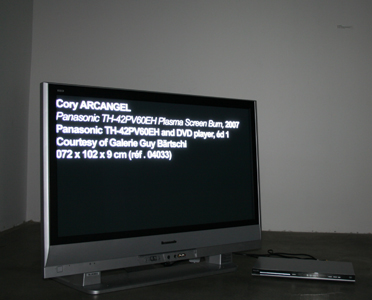
Cory Arcangel’s Panasonic TH42PV60EH Plasma Screen Burn, 2007 (also via VVork)
Bonus: Nominee for Worst Theoretical Justification for an Artwork in 2007
from T.Whid:
Arcangel’s "Panasonic TH42PV60EH Plasma Screen Burn" is brash and bold, it says "fuck you, I’m fucking up this expensive piece of equipment. Why? Because I’m motherfucking Cory Arcangel that’s why!" Steven Read's piece is nitpicky and fussy. His piece says “look! I wrote a program to destroy an obsolete piece of hardware. Why? Because I’m a geek." Arcangel’s piece is about fucking with consumer dreams. Read's piece is about… time and phosphors?I would personally like to see Arcangel going back to destroying obsolete pieces of hardware instead of acting like a jaded rock star. I know some artists who could do some cool things with that plasma screen. (Also, we're taking it on faith that the screen is actually destroyed--in any case, if the gallery sells it, it's contractually tied up as an expensive name plate, which is practically the same thing.)
Previous clone attacks
Aron Namenwirth did a studio visit today, and took some nice photos, which are here.
The issue came up about people in the art world saying, regarding exhibits, "Yeah, I saw the show, I saw it on the Internet." Should galleries not post documentation so people will get off their lazy butts and come to see actual work? Cory Arcangel also addresses this matter in a transcription of a recent talk he gave, but from the reverse vantage point--he describes work he's seen on the Internet to people sitting in "real space" without a computer as an audiovisual aid. [Update: a friend noted that I am completely wrong about this--it reads like a transcription but appears to be some kind of stream of consciousness typing about the internet, to be read on the internet, but where no links are used.]
I'd been putting off the list of "art YouTubes" he and Hanne Mugaas recently published due to general leeriness of "art about art" and it feeling too much like homework. Certainly one could live without ever seeing the Italian Vanessa Beecroft interview again, but there are bad boy surprises lurking in the roster, too, such as this tribute to Barbara Kruger.

Generation - Artist Unknown
From Yahoo News/AFP:
Cheney...used his appearance before the Republican Jewish Coalition in Manalaplan, Florida, to reassure allies that the current political struggle [the House "antiwar" vote] will not result in a precipitous US withdrawal from Iraq.The vast majority of combatants in Iraq are not jihadists but Sunnis and/or (secular) Baathists who were kicked out of power when the US invaded. Cheney is taking advantage of Americans' ignorance and apathy regarding these basic facts to continue to spread fear.
"A sudden withdrawal of our coalition would dissipate much of the effort that has gone into fighting the global war on terror, and result in chaos and mounting danger," the vice president declared. "And for the sake of our own security, we will not stand by and let it happen."
He did not explain what steps the administration could take if the supplemental bill dies in partisan bickering. But he expressed confidence in the final outcome, stating "We will complete the mission, and we will prevail."
Quoting extensively from Al-Qaeda leader Osama bin Laden, the vice president reiterated his conviction that an US early withdrawal from Iraq would be "a complete validation of the Al-Qaeda strategy."
And he painted a dire picture of the Muslim world descending into chaos and tyranny, if radical Islamists were allowed to prevail.
"Having tasted victory in Iraq, jihadists would look for new missions," he predicted. "Many would head for Afghanistan and fight alongside the Taliban. Others would set out for capitals across the Middle East, spreading more sorrow and discord as they eliminate dissenters and work to undermine moderate governments."

This image from a stylish utopian architectural scheme proposed in Sweden comes via the VVork site. It reads like satire:
Kymlinge was a research and consultation project on new ways of developing towns in Sweden. We proposed a model of simulated organic growth, in part inspired by strategy and RPG games: We would start by installing low cost raw "industrial" spaces that would attract young people with the ikea energy to fix them up. This demographic would start-up a new area of Stockholm, creating at first a solution to the housing problem, and leading into the area gradually becoming a "cool" destination inside the city.The planned community (assuming this isn't a hoax) is essentially just a Levittown, Reston VA or Disney Celebration for these imaginary loft-living hipsters. Note that the words industrial and cool are in scare quotes. The equation of Ikea consumption and a counterculture is very slippery: the assumption is that if you give an energetic young person a non-traditional, urban, loft space, creativity and a happenin' scene will follow, but you can't always make the prisoners dance in their cells.
The computer designs are intriguing in a Donald Judd, Sol LeWitt open cube variation sense. I had an earlier version of this post up relating them to musical scores (mine, but never mind). The project appeals more as art than as social policy, which seems unnecessarily Skinnerian and manipulative.
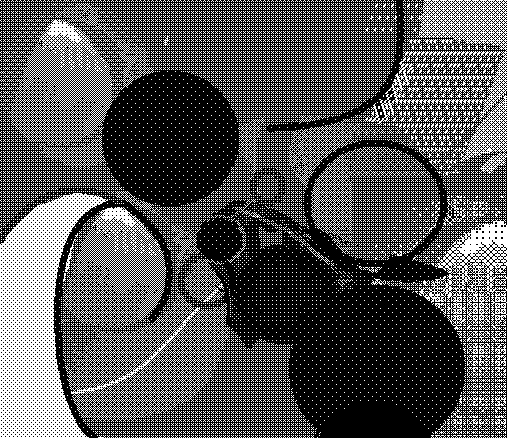
Active Worlds vs Second Life
Was talking to someone recently who didn't know the former, a kind of also-ran in the buzz metaverse, or buzz about the metaverse, if you prefer. Posting these links for further comparison. I recall a "Virtual Chelsea" in Active Worlds with wireframe modernist gallery buildings, from about 8 years ago, that never quite got off the ground. Avatars could meet, talk art, and look at painting thumbnails mounted at oblique angles. It's all Lawnmower Man kitsch but interesting to think about the different ramifications of the "fully-immersive" Matrix paradigm (some wildly successful and some not), still grinding on while new social networking schemes based on much less memory intensive tech (MySpace etc) take off even more.
Middlebrow Democrat sites such as Daily Kos tell us the "antiwar" legislation just passed by the US House is good because it makes Bush look bad, or something. Justin Raimondo at antiwar.com notes that "the bill gives more money for the military than requested by Bush." In a blog post today, Raimondo responds to David Sirota, "the resident 'radical' over at the HuffPuffPost," who thinks the legislation, which Bush will veto if it ever gets to his desk, is just grand.
In a veritable cascade of Orwellian doublespeak, Sirota claims:Why should we accept a "compromise," anyway? The majority of Americans want to end the war and disagree with Bush's handling of it; every day that passes means more money spent and more lives lost in the 52nd State.It is a courageous move because it is never, ever easy to swallow a compromise, even if it is clearly the right thing to do to achieve long-term goals. These Members of Congress played hardball from the beginning, and that hardball made sure this bill included strong, binding legislation to end the war.If this is "strong and binding," then one can only wonder what would be weak: read it and you'll find that the actual wording of the legislation leaves it up to the White House to "certify" whether "progress" is being made in Iraq -- in which case none of the requirements, including a withdrawal of our forces from Iraq, have to be met. It’s true that such a certification would only delay "redeployment" of our troops, but then all the President has to do is assert that forces remaining in Iraq after March 1, 2008 are specifically in pursuit of Al Qaeda, or other terrorist groups with "global reach" -- which is the argument he’s been making since Day One -- and they can stay -- indefinitely.
This is "strong" and "binding"?
"Enigmatic Rap" [mp3 removed]
Update: attempt to relate this to dubious utopian architecture purged for the time being. I am working on a piano version while thinking about how to best describe it.

vvebkm (YouTube) (petra cortright)
Update: We're discussing this project over at Paddy Johnson's.
NASTY NETS YOUR CREW IS WACK, YOUR LINKS SUCK, AND Y'ALL GOT SWAGGER JACKERS UP IN YOUR CUT. AS JWW SAID WE CAN RELATE THIS BEEF TO CURTIS + CAM’RON. NASTY NETS IS 50 CENT AND YA'LL JUST GOT SONNED BY DIPSET A.K.A. SUPERCENTRAL. JEAH!
- marky mark — 3/16/07 @ 11:23 am
WE'RE NASTY NETS OUR CREW IS WACK,
OUR LINKS MIGHT SUCK
BUT WE DON’T SMOKE CRACK
WE GOT SWAGGER JACKERS UP IN OUR CUT
BUT THAT'S BETTER THAN HAVING THEM UP OUR BUTT
SONNED BY DIPSET THIS IS GOOD
AOL IS YA'LLS HOOD
NASTY NETS IS 50 CENT
BUT SUPERCENTRAL IS ALREADY SPENT
MARKY MARK DOESN’T EVEN RAP AT ALL
HE JUST RANTS WITH BLOCK CAPITALS. JEAH!
- tom moody — 3/17/07 @ 1:39 pm
Reenacting the Unenacted?
About The MusterA friend attended this event and said it was ridiculous. Semi-diverse clumps of artists standing around looking clueless, waiting for some leadership or an idea to emerge, with no common purpose except the need to be "seen" and the vague desire to "help out." Reenaction is an interesting social phenomenon--so what? "What are you fighting for?" is a "When did you stop beating your wife?"-style question, in that it assumes you are fighting and the questioner doesn't know why, and one should have the good sense not to answer it, thus saving yourself becoming fodder for a coffee table book. Perhaps one purpose the mustering served was to parody the Iraq war protest marches of '03, where every leftist "cause" under the sun was represented and the participants were so busy working on their funny signs and costumes they forgot what was needed--a grim unified front, hundreds of thousands strong, to stop the coming senseless slaughter. Somehow parody doesn't seem like the idea behind "The Muster," though.
On May the 14th, 2005, artist Allison Smith transformed Governors Island – the former U.S. military base located only minutes by ferry from the southern shore of Manhattan – into a stage for an unforgettable work of public art, commissioned by the Public Art Fund. Inspired by American Civil War battle reenactments, The Muster was a "polyphonic marshalling of voices" in which Smith invited artists and non-artists alike to declare a cause and create a campsite-installation in response to her question: "What are you fighting for?" Combining celebration, art, craft, history and activism, this earnest and jubilant event embodied the complexities of its political, aesthetic, and cultural moment.
Allison Smith is a New York-based artist, whose diverse practice investigates the cultural phenomenon of historical reenactment, or living history, using it as a means of addressing the relationship between American history, social activism, craft, and queer identity. Her work has recently been seen in exhibitions at Artpace San Antonio; Palais de Tokyo, Paris; Andy Warhol Museum, Pittsburgh; P.S. 1 Contemporary Art Center, New York; and elsewhere.
Produced with the inimitable flair of the ever-talented graphic designer Jorge Colombo, this book documents the Muster and places it within broader contexts. Included are more than 140 photographs, a foreword by Susan K. Freedman, President of the Public Art Fund, and essays by Tom Eccles, curator of the project and director of the Bard Center for Curatorial Studies, James Trainor, US editor for Frieze, Anne Wehr, Communications Director for the Public Art Fund, and "Mustering Officer" Allison Smith.

1997 JODI interview
?: Aren't you afraid that your work will disappear at one point because of technological paradigm changes? For example, that it can't be viewed anymore because browsers change overnight?via camille pb. Update: Another excerpt, about the differences between European and American Internet surfing. This has changed now, I assume?
Paesmans: Fear is not a good condition for work. We have no fear. We make these things because we are angry. People perceive this anger when they are on the other end, at the receiving computer...
?: Why are you angry?
Paesmans: Because of the seriousness of technology, for example. It is obvious that our work fights against high tech. We also battle with the computer on a graphical level. The computer presents itself as a desktop, with a trash can on the right and pull down menus and all the system icons. We explore the computer from inside, and mirror this on the net.
When a viewer looks at our work, we are inside his computer. There is this hacker slogan: "We love your computer." We also get inside people's computers. And we are honored to be in somebody's computer. You are very close to a person when you are on his desktop. I think the computer is a device to get into someone's mind. We replace this mythological notion of a virtual society on the net or whatever with our own work. We put our own personality there.
?: There is this rumor that your site causes people's browsers to crash. Is this true?
Heemskerk: No. That is not a challenge. You could shut down anybody's computer with one line of code. That's not interesting.
?: My impression is that a lot of people look at your site briefly, and then go somewhere else, without ever exploring the details of it: "Oh, there is this site that looks like your computer is broken", and then it's back to CNN or Yahoo or whatever. Does that bother you?
Paesmans: No. Media art is always on the surface. You have to get people very quickly. You need to give them a karate punch in the neck as soon as possible. And then - of course - they don't get to the details, and the site will just sit there for the next five years or ten years, or maybe 100 years. And maybe their children will have the time to explore the details... (laughs)
?: I remember that one of you made a remark about the difference between the European and the American internet. This seems strange, because the internet is supposed to be an international network, that surpasses national boundaries. What do you mean with this, and how does this difference affect you as artists?
Paesmans: The Americans don't have to pay for their connection time...
?: ...because local calls are free in the US...
Paesmans: ...so the internet is just an extension of their local computer.
Heemskerk: It suits their geographical sense as well, because some places are so remote, that they need a means of communication. Not only the internet, but also the telephone. If you pick up the phone in the Netherlands and call somebody in Germany it seems really far. But in the US they spend hours on their phones with their neighbors.
Paesmans: And it's the same with the internet: home office workers for example can stay online for hours, because they don't have to think about the telephone costs.
?: And how does that affect you as artists?
Paesmans: We cannot explore the net the way we want to. For example we cannot check the dutch newspapers in the morning on the net, because connection time is too expensive. You can look at your email, but you cannot look around for an hour, because you have to pay the expensive morning rates for a local telephone call.
Heemskerk: The result is a whole different way of viewing. If you have to pay for the hour you want to see something immediately. You are not prepared to look for something for an hour. But you have to do this on the internet.
Paesmans: Otherwise you just log into the little areas you know. It doesn't become this jungle where you go to discover things you did not know before. But this is just the interesting part of it. It is fun to find things from the Philippines or Morocco. So you have to get organized and do your surfing at night, because the rates are cheaper then.
?: How many hours do you spend online per day?
Paesmans: Not many. Maybe half an hour. If we are working on something it might be longer. I like to look around at Japanese sites, which are incomprehensible to me. The characters are totally unreadable, and they have beautiful screen designs.
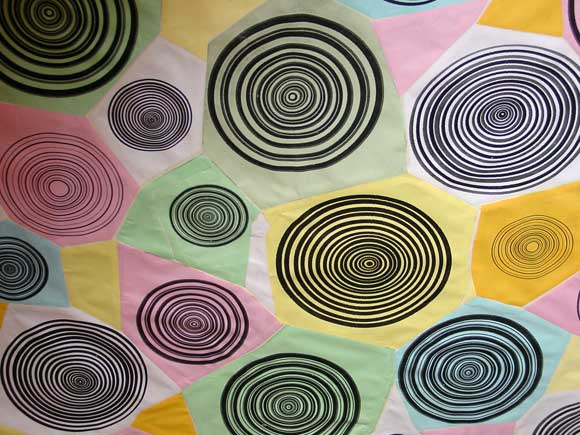
Great takedown of New York Times warmonger Thomas Friedman by Matt Taibbi. Here's the News Blog's edit:
'What we have to remember about America's half-baked propaganda machine is that, dumb as it is, it always keeps its eye on the ball. The war in Iraq is lost, everyone knows that, but there are future wars to think about. ... we always have to make sure that the excuse for the next war is woven into the autopsy of the current military failure. That's why to this day we're still hearing about how Vietnam was lost because a) the media abandoned the war effort b) the peace movement undermined the national will and c) the public, and the Pentagon, misread the results of the Tet offensive, seeing defeat where there actually was a victory.
'After a few decades of that, we were ready to go to war again [in Iraq] -- all we had to do, we figured, was keep the cameras away from the bloody bits, ignore the peace movement, and blow off any and all bad news from the battlefield. And we did all of these things for quite a long time in Iraq, but, maddeningly, Iraq still turned out to be a failure.
'That left the war apologists in a bind. If after fixing all of the long-held Vietnam excuses Iraq could still blow up in our faces, that must mean that we not only misjudged Iraq, but we were wrong about why Vietnam failed, too. Now, if we're ever going to pull one of these stunts again, we're going to need to come up with a grander, even more outlandish excuse for why both wars were horrible, bloody failures.
...
'[According to Friedman] both Vietnam and Iraq failed not because they were stupid, vicious occupations of culturally alien populations that despised our very presence and were willing to sacrifice scads of their own lives to send us home. No, the problem was that we didn't make an effort to "re-evaluate tax and spending policies" and "shift resources" into an "all-out" war effort.
'We're talking about one of the richest men in media, a guy who in recent years got still richer beating the drum for this war from his $9.3 million, 11,400 square-foot mansion in suburban Maryland. He is married to a shopping mall heiress worth nearly $3 billion; the Washingtonian says he is part of one of the 100 richest families in America. And yet he has the balls to turn around and tell us that the pointless, asinine war he cheerleaded for failed because we didn't sacrifice enough for it.
...
'[T]rust me, the myth is going to be that you didn't cough up enough for the war. It's your fault we failed, not Tom Friedman's.'
Reddy Kilowatt commercial (1950s). From a time when we needed to be told about the virtues of electricity. (via WFMU)




















mosaic GIF - artist unknown - 15 times
not intended for RSS readers or Safari browsers









bubble GIF - artist unknown - 9 times
not intended for RSS readers or Safari browsers
Baby Sloth [YouTube]
Unrelated to baby sloths: I was recently invited by another blog to do some critical writing for it. I was flattered by the request but replied that I was mainly focused on my own art and music and wasn't really doing reviewing outside my own domain. (My FAQ page sort of explains why--art world damage.) I said I was happy to have anything on this page reblogged, so it wasn't really a no. The person who emailed definitely took it as a "no," though. There is much good writing about art on the Net (as well as crap) that's yours for the asking--I don't know why it should have to "originate" on the site that publishes it. What's wrong with a collage of writing? Kathy Acker-like. Some blog items don't get picked up because they're too "controversial" (woo, scary). I appreciate someone "having my back" occasionally, as they say in the Army, when I go out on a limb and...express an opinion. Paddy Johnson could probably use a pat for daring to... have guts. (She called Queen Roberta a bad writer! No one in the New York art world ever stands up to the Queen and Jer.)

























not intended for RSS readers; no guarantees on Safari
From Jim Henley:
Hillary Clinton says our withdrawal from Iraq should involve leaving 50,000 troops in Iraq that will continue to conduct combat operations and will continue to need supplying along Iraqi roads and continue to need a massive helicopter and jet presence in Iraq’s skies. The only thing they won’t do, somehow, is involve themselves in Iraq's civil war, which will be quite some trick given that one side of the civil war goes out of its way to attack American troops and the Iraqi government and its constituents; this is also the side we'll continue to conduct combat operations against. The other side is the Iraqi government and its constituents; elements of that side sometimes attack us too, though from what I can tell they mostly only do this when we step all in their shit.Looks like another "hold your nose and vote" scenario come '08, barring some miracle.
You might wonder what the Iraqi government thinks of this grand strategy of the Senator's. The only reasonable interpretation of her statements as reported in the press is that the Senator could care less, thank you. We will stay in Iraq "north of Baghdad" for reasons independent of any wishes Iraq’s government might hold. We’ll "protect the Kurds," whom Iraq's government may not wish protected quite so much, and "counter any Iranian moves into Iraq" that Iraq’s government may not want countered. We will, in other words, do whatever the hell we want in Iraq. We will run the place, but without the fuss and bother of providing security for the citizens or delivering services. The Iraqi government is welcome to "get its act together" if it wishes, which should be easy to do when a foreign country is maintaining 50,000 troops who will act with impunity anywhere within its territory.
There are two words for this kind of military posture: occupation and war. We have those now. Senator Clinton says we should keep having them until the last date has dried into the last fig. She’s just going to try to make it a little quieter for us, and be a little lazier about it.
Update: Juan Cole further demolishes Clinton's justifications for continued US occupation.
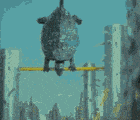
via 4Chan
This just popped up in the Rhizome Raw* RSS feed:
Public tribute for Jean Baudrillard on World of Warcraft.I shouldn't laugh at this, but now whenever I hear "World of Warcraft" I can't get the image out of my head of the South Park episode with the bloated pasty middle aged man with skin diseases who sits at his computer all day eating junk food and racking up obscene numbers of points killing everyone in Warcraft. Would Baudrillard have "gotten" that?
Ars Virtua will be holding a public tribute to honor the late social and political theorist Jean Baudrillard. Jean Baudrillard's criticisms and view on Simulation are influential to our discussions of the MMO.
This short program will be held on the WoW Kilrogg server, 4-5pm PDT, March 17, 2007 near Orgrimmar. Please send tell to Zuluu upon arrival in-world for the location.
Ars Virtua is a new media center and gallery located primarily in the synthetic world of Second Life. It is a new type of space that leverages the tension between 3-D rendered game space and terrestrial reality, between simulated and simulation. Ars Virtua is sponsored by the CADRE Laboratory for New Media.
*Update, 2011: The Rhizome link has been changed to http://rhizome.org/announce/events/47095/
From Paul Slocum's blog comes this item about an alternative for working musicians to the iTunes store. It's called SNOCAP, started by the original Napster guy. The scheme makes it possible for you to have a "store" on MySpace (or any other page you control) and sell non-DRM'd mp3s for 99 cents, of which SNOCAP keeps 39 cents.
Downside: they want access to your bank account to debit and credit funds electronically. I'm just wrapping my head around "Check 21"--the law that lets utilities and credit card companies dun your account by "electronic funds transfer" when you send them your monthly check. (Yes, I still like a paper trail.) How'd that get passed? Oh, right, never mind. You'd probably want to set up a separate account, which costs extra if the bank considers it a business account.
Update: Jim has more on the big picture and SNOCAP.
Dallas Morning News on John Michael Boling's and Javier Morales' video Blood Fantasy, showing at And/Or Gallery:
In quoting 1980s video footage, the two artists twist the temporality of "obsolescence." We recognize that the styles of clothing, hair and eyewear are out-of-date yet the crispness of video, its color and image resolution, seems perennially present. Blood Fantasy uses a similar grammar of mixed imagery, creating a greater sense of abstraction in the juxtaposition of figures and patterns: aerobics dancers, King Tut, a woman breastfeeding, and sequences of pixilated light in blue and fuchsia.D'oh, I've seen this video, and somehow the writer forgot to mention the footage of the woman hung upside down having her throat cut, from a low budget horror movie that looks a lot like the Berg beheading video, production value wise. Gouts of stage blood spurt from her neck and pour down her face as she screams. You can't miss it--it's about a minute into the DVD and lasts about 30 seconds. It probably has something to do with the title, Blood Fantasy.
This information was brought to you by BlogsTM--Your Supplement to Mainstream Media.

"Bonsoir Bonaire Variation" [mp3 removed]
Rescored "BB" for the "Exit Maurice" Sidstation patch (aka ChordMemry) with some filtering effects, for a slightly more rave-y feel. Kept the original electric piano plus the bare bones of the drums for this variation.
hypercube artist unknown
"Maurice Flambeed" [mp3 removed]
Another tune entirely, but using the same patch as "Bonsoir Bonaire Variation," plus an analog four-part bassline I'm really happy with.
camille.pb on the interview I did with Paddy Johnson and Michael Bell-Smith last year:
...they discuss the traditional distinction between low art and high art and bring their new perspective, consisting in making the most out of easy webtools (via an interesting discussion of the animated gif's qualities for instance). The phrase Software art as I study [it] can be deceiving: one could think it has to do with super high-tech up-to-date and expensive software used by experts. Same for the word art, which could easily be interpreted by its application in the high fields of art history and institutions. When the two come together, though, here is the twist: they seem to degrade each other - and that's where the fun is: "art becomes web junk" says M. Bell-Smith. [...The artists] also develop a non-political stance, and it's interesting to find a way out of this boring debate of what is political art. It gives way to an idea of art practice that is not political by representation but by practice, by the context in which it is elaborated, by other stuff that the artist does and that he does not call art; Tom Moody's blog is filled with newspapers' extracts on american political life but in the interview he claims the right to political irresponsibility. I once heard the same words spoken by the net.art duo JODI: "the freedom to be irresponsible in front of one's computer," says Dirk Paesmans (in Matthew Mirapaul's 4/21/03 NY Times article "Distorting the digital mechanism").A good role model is the American proto-Pop abstractionist Stuart Davis, who was active politically but largely kept it out of his art. Writing in The New York School: A Cultural Reckoning, 1973, Dore Ashton tells an anecdote about his formative years, before the First World War:
[committed socialist John] Sloan was the artistic director of the radical magazine The Masses, to which Davis, Glenn Coleman, and Art Young contributed visual commentaries, based very often on their observation of the city, especially of the impoverished immigrants. Not long after Sloan arrived at The Masses, an ideological battle developed in which Max Eastman, John Reed, and Art Young insisted that only an art of "ideas" had a place in the magazine, by which they meant an art fully captioned. Art Young, whose life, as he wrote, was dedicated to the destruction of plutocracy, was an uncompromisig propagandist. Opposed to them were Sloan, Coleman, and the young Davis, who stood for "pure" art (genre scenes that needed no captions). In the dispute that ended his cartooning career, Davis learned, as he said, to be forever suspicious of "an art of ideas" and in fact, even when he was in the thick of political agitation later in the thirties, he never again brought his art and politics together.(To reiterate what I said in the interview: "Art should be like dreaming, and dreams don't always take us to good places, or places we want to go. Is it good for art to be 'apolitical' when the country is being driven off a cliff by fools? One person's frivolous pleasure states could be another's rejection of, or opting out of, the dominant control systems. I'd rather allow art to be 'immoral' and 'irresponsible'--and then analyze why I feel that way.")
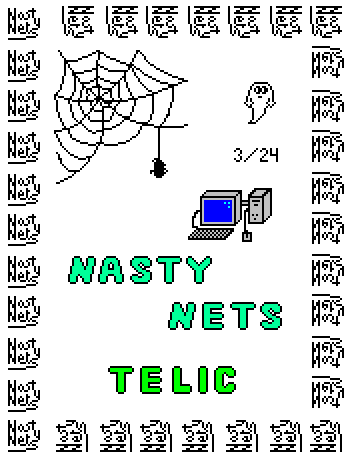
Poster by T. Hallenbeck for Nasty Nets Los Angeles event. No idea what this event is about except that my left coast sisters and brothers will kick the asses of rival surf club supercentral.
From musician/popstar Thomas Dolby's blog. He recently attended the TED conference (Technology, Entertainment and Design) and lists this as a highlight:
-My Indian buffet lunch table today with Richard Branson, Peter Gabriel, Hans Rosling and Darryl Hannah (!) as they discussed how to get the world’s "Elders" into war situations to help resolve conflictsLimousine liberals, e-e-ew. Surely we've learned from Iraq that there are no Elders, and the main beneficiaries of "getting us into war situations" are arms merchants, support for whom needs to be ratcheted down, not up. In fairness to Dolby, he possibly means negotiation, not troop involvement in foreign conflicts, but it's doubtful.
"Bonsoir Bonaire" [mp3 removed]
The Pro 53 (softsynth) has a nice e-piano sound. Here it's layered over a bed of growly autopanning sawteeth and random bipolarly tuned snares. Will eventually run out of Caribbean islands to use as titles, but I like that Google translates Bonaire as "good surface."
Some excerpts from Alan N. Shapiro's forthcoming book TV’s "Lost": The Crash Out of Globalization into the World:
In my media studies writing on Lost, I continue my project of inventing the literary genre of theory-fiction that I began in my book Star Trek: Technologies of Disappearance...writ[ing] first-person phenomenological narratives of what each of the 14 major characters of Lost is feeling, perceiving, thinking, and experiencing from moment to moment. [...]Woven into Shapiro's cyber-fanfic sketches are autobiographical passages, a hilarious Marxist takedown of Defoe's Robinson Crusoe, and an aeronautic prequel channeling Charles Lindbergh's first Transatlantic voyage, all relating to Lost's themes of flight, trauma, and survival (having only read the wildly un-linear excerpt we trust that the author will pull all this together). The close reading of episodes and willingness to see beyond their TV trash status to bigger issues is what made the Star Trek book so successful--it's the viewpoint of a skeptical fan, perfectly situated to explain why these series have become contemporary mythology, for bad or good. On the "unexamined psycho-biographical wound" that Jack wakes up with after the crash:
All of the[m] - male and female - are my sexual identity avatars. They are virtual reality body-suits that I freely robe and disrobe. I inhabit their bodies and clothing as I choose. I exist inside their semiotic silhouettes. [...]
As the Pilot Episode begins, I wake up from oblivion as Alpha Male Jack Shephard, supine and homeless alone in the woods after a devastating aviation accident. It is my very first arrival in this particular virtual party-experience scene-space, a personal appearance financed by part of my Cable-TV subscription monthly fee, and enabled by the technological meat-machine interface of my image-saturated commodity mind. I exit the transient wormhole-like void of precision-instrumented passage between worlds quantum-leapt into an initiatory moment of surprising arousal. From now on, whatever Jack sees, feels, touches and hears, I see, feel, touch and hear. I am Jack. Jacked in.
Countless contemporary TV shows and Hollywood films portray America's exemplary heroes: emergency physicians, homicide detectives, attorneys for the defense, secret service agents, counter-terrorism specialists, life-risking firemen or beat cops. These daring occupations encompass weighty responsibilities and are undoubtedly among the noblest of vocations in today's society. But the omnipresent virtual realities of the media propagate an iconography of the trained practitioner who "does good" or "helps others" that half performs the commendable service of showcasing worthy role models and half does the disservice of manufacturing a manipulative mythology of the obligation to make excessive macho self-sacrifices for the public interest.The Crash Out of Globalization, then, is, among other things, landing on the island and confronting this compulsive workaholism of a life that no longer exists. One's only fear is the series may be overwriting the writer as it morphs in Seasons 2 and 3 from a post-technological survivalist narrative to a Lost in Space-like scenario teeming with abandoned spooky gear, spacetime abnormalities, and a steady stream of weird visitors that manage to heat the rat race right back up. Shapiro's challenge is to make his narrative so powerful that people will only think of the bucolic, pre-Dharma episodes when they envision the series.
The small and big screens hook us seductively into the pervasive workaholism corresponding on the level of the individual to what the German philosopher Martin Heidegger - in his 1936 essay "The Age of the World Picture" - correctly diagnosed as being the plague of modern times: the characteristic bustle or constant "industrious activity of mere busyness" of our oppressive institutional existence. Permanently enchained by the everyday life ideology that constrains me to make my contribution to business, family, nation, or the accumulation and spending of money, I operate nonstop in a pumped-up feverish caffeine-assisted trance of work and consumerism in order not to face myself. I never have to ask the terrifying question of what I would do with my life if I were truly free. Especially as a man, I steer clear of contact with my own feelings and emotions, evade looking sincerely into my own psycho-biographical pain, and fail to develop real self-love...
Related, more solipsistic Lost thread--one man's lonely vigil.
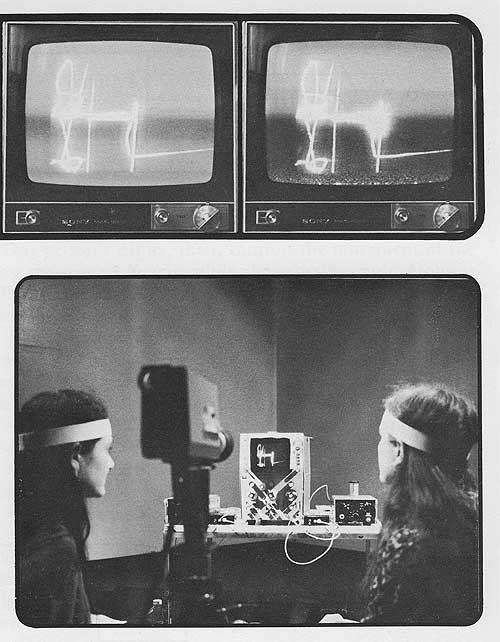
Jacqueline Humbert, Brainwave Etch a Sketch, 1974. "One person's Alpha waves control the movement of a dot along the oscilloscope's X axis, while the other person's are responsible for movement along the Y axis. The resulting form of the drawing depends on the degree of cooperation, sensitivity and agility in consciously controlling brain signals that the two participants are able to achieve with each other." (Quote and photos from Biofeedback and the Arts, 1976, ed. by David Rosenboom)
A blogsitter over at The News Blog while Gillliard is in the hospital (Get well Steve!) has floated a "best science fiction/fantasy books" list that seems a bit heavy on old "hard science" dudes such as Asimov, Heinlein and Clarke. In the comments yours truly tried to add some dystopian/visionary/cyberpunk spice (including a scattering of books written after--gasp!--1980) with these suggested additions:
A.A. Attanasio - The Last Legends of Earth, Radix
Alan Moore/Dave Gibbons - Watchmen
Brian Aldiss - Non-Stop, Hothouse
Philip K. Dick - Ubik, Martian Time Slip
J.G. Ballard - The Crystal World, High Rise
Pohl & Kornbluth - The Space Merchants, Wolfbane
Bruce Sterling - Schismatrix Plus, Heavy Weather
The Strugatskys - Roadside Picnic
Stanislaw Lem - Solaris
Greg Egan - Quarantine
Greg Bear - Blood Music
Octavia Butler - Earthseed novels
Michael Swanwick - The Iron Dragon's Daughter
Doris Piserchia - Doomtime
John Brunner - The Shockwave Rider
Lem, Butler, Pohl & Kornbluth, Brunner, and various Dicks already had their indignant supporters in the comments--just tossing in this blog's two cents on those authors. Cordwainer Smith would be on the list except his best work is in the short story format. H.P. Lovecraft's At the Mountains of Madness, Poe's The Narrative of Arthur Gordon Pym, and H.G. Wells' The Island of Dr. Moreau are some late thoughts.
"Mouse Party 2" [mp3 removed]
Back to the sampler--these are sampled drum hits from the Vermona rhythm synth, using the "kit" made last summer. Tried a couple of new things: making midi controller curves change the snare's pitch and tuning a "chime" (itself a chord) so it could be played like a piano (the melody's pretty basic). A few effects added here and there. Most of the rhythmic interest comes from the "claps."
Update: Discovered this was clipping slightly. Fixed that, and fattened up the sound a bit.
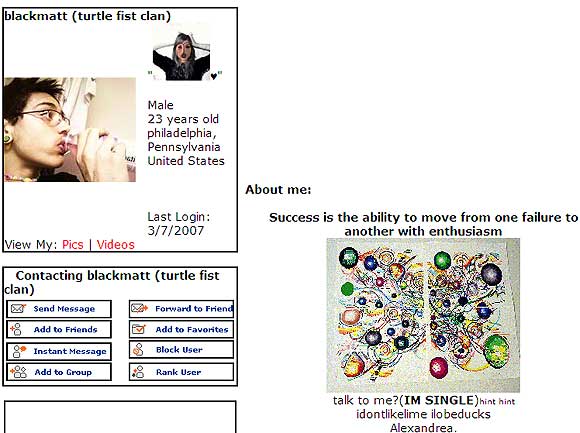
Interesting sounds/patterns/glitches by Mary Benedicto: Loops, Flowers, The Swarm, others... The music is in the Pole/Boards of Canada spectrum (albeit fragmentary) and the visuals are consistently psychedelic/oceanic but also cut up electronically so that you are not allowed to completely "sink into" them.
Also, thanks to Nasty Nets East for introducing me to Silicious (Kathleen Daniel), who rules YouTube with pleasantly deranged music and video of her own creation. The tunes are especially accomplished, melding classic R&B crooning, ESG-style electro-funk, Sun Ra tonal adventurousness, and garageband. (Check out Georg--that Giorgio Moroder bassline with the "la di da di/we like to party" chorus is to die for). I prefer the videos with free-floating Bryce or Poser characters to the obvious Photoshop filters, but it's all pretty great--Henry Darger-esque but with a heart and a conscience and healthy as opposed to brutal sexuality (and in 3D and 4D as opposed to 2D and 4D).









["Planetesimals" video removed for now--these captures are the "piece" (I think it works as a full-sized video but I wasn't happy with the Quicktime).]

artist unknown - hat tip to SHM
Rest in Peace, Jean Baudrillard. Without you the art world since 1982 or so would have lost all meaning and purpose. Let the inevitable hyperrealization of your life and work begin.
text buffer from wikischmedia:
Much of Baudrillard's notoriety as an academic and political commentator comes from his deliberately provocative claim in 1991 that the first Gulf War 'did not take place.' His argument — which sparked heavy criticism from the likes of Chris Norris ... who perceived, in Baudrillard, a denial of empirical events — described the war as the inverse of the Clausewitzian formula: not 'the continuation of politics by other means', but 'the continuation of the absence of politics by other means.' According to Baudrillard, Saddam Hussein was not fighting the Allied Forces, but using the lives of his troops as a form of sacrifice to preserve his power (p. 72 in the 2004 edition); and neither were the Allied Forces fighting Saddam, they were merely dropping 10,000 tonnes of bombs a day as if to prove to themselves there was an enemy to fight (p. 61). So too were the Western media complicit, presenting the war in 'real time' and recycling images of war to propagate the notion that the two enemies were in actual conflict. But, Baudrillard followed, this was not the case: Saddam did not use what military capacity he had (his air force); nor was his power eventually weakened (as he managed to put down the insurgency against him after the war ended). And so, Baudrillard concluded, little politically changed in Iraq: the enemy was not defeated, the victors were not victorious. Ergo, there was no war: the Gulf War did not take place.

hat tip to steve
Update: the text originally published here had little to do with the above image. The picture is complete unto itself, a visual one-liner, not requiring a word of explanation or elucidation. (Except that it's a great bit of real-life performance art.) Unfortunately the photo was "vibrating badly" with the one below it on the page, to use curator Walter Hopps' term for two unharmonious paintings in an exhibition hanging. He would sometimes substitute a lesser picture next to the one he considered the masterpiece to remedy this. On the blog another solution is to have a "text buffer"--some random snippet that insulates the two images from each other. Unfortunately including text in the same blog post (out of sheer laziness of not wanting to create an intervening buffer post, which is an involved process) inevitably invites relating such text to the image above it. It was hoped that Paul Virilio's thoughts about "the accident" (yanked from Wikipedia and now moved to the comments) could be read ironically in tandem with the firehose picture, since what it depicts is not an accident--but that's asking a lot in a fast-reading blog scenario. Thanks to K for noting the problem. This meta type text now serves as the buffer. blah blah
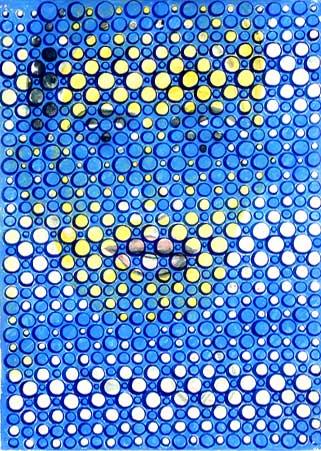
DAVID MORENO
Untitled, 2002; ink on paper; 12.75 x 9.25"
#6 of a suite of 6 (image from Feature Gallery website)
Never seen this piece in person. It might well work better as a web graphic than an object. "Graphic" meaning art, it should be added, but having a particular punch or "read" in the concise, compressed format of a web page. "Accidental enhancement" or "second-level improvement" should be added to the criteria art historians consider in evaluating work.
A breakthrough moment on this score occurred a few years ago when the Museum of Modern Art collected several of Van Gogh's "postman of Arles" paintings for a small group show. The museum couldn't get loans for all of them, so one was represented by a digital reproduction, mounted on a panel so it read like a painting. With its bright, saturated colors, crisp "sharpened" resolution, and excellent lighting, it stole the show--making the others appear dingy, old, and fussed-over.
Addendum to an earlier post: In addition to VVork Annotated, we also need the Anti-VVork. The latter consisting of art projects with no explanation, purpose, socially conscious rationale, tag line, or associated sound bite. It would be art not reducible to or reproducible as photography. It would be private jokes, arcane abstractions, and/or noise with no discernible or announced organizing system. It would be bad art, failed art, non-art (i.e. found things with no original purpose as art), and "embarrassing" art (i.e., too personal, too self-revelatory, too unhip or "square"). It would be expressionistic as opposed to ironic, not the faux expressionism of the current New York painting world but some kind of atavistic, unassimilable emotion. Just trying to think of everything VVork is not. More items will possibly be added.




more eyekhan vs moody vs eyekhan / bigger
not intended for RSS readers; no guarantees with Safari
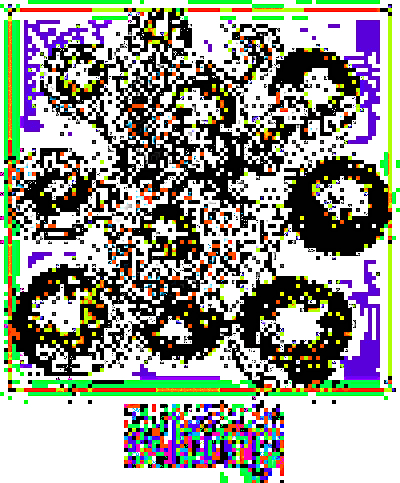
extensible cluster frame e remix by eyekhan
The New York Times vs Triple Candie Part 2.
The following correction appears in today's Times, concerning a Martha Schwendener hit piece on Harlem's Triple Candie gallery. How is possible to get so many things wrong in a review? The correction doesn't even address Schwendener's imputation of a revenge motive for the show--which is the official script for critics from the New York media writing about the gallery. (For those who haven't been following, the media keeps claiming that the gallery shows facsimiles or photocopies after being turned down for originals, with David Hammons, Cady Noland, and now George Eastman House, none of which is true. See The New York Times vs Triple Candie Part 1 and this post.)
Correction: March 3, 2007Here is the semi-corrected Schwendener review, which still includes the errors about the gallery's mission and the "revenge against Hammons" canard that the Times apparently forgot it already corrected:
A brief art review in Weekend yesterday about “Limelight,” an exhibition at the Triple Candie gallery in Harlem based on a 1959 show at the Limelight coffeehouse and gallery in the West Village, misidentified the content of the original show. It included reprints of photographs by major artists lent by the George Eastman House in Rochester, not originals.
The review also misstated Triple Candie’s dealings with Eastman on the current show; it did not request a similar loan from that institution and thus was not denied one. And it referred imprecisely to the history of the gallery. Triple Candie says that its goal is to provide Harlem with a site for contemporary art and artists with opportunities unavailable in commercial galleries; its original mission was not to show the work of Harlem artists.
LIMELIGHT
Gallery and Coffee House,
1954-61
Triple Candie
461 West 126th Street, Harlem
Through March 18
From 1954 to 1961, Helen Gee, photography maven and skilled photographic retoucher, ran the Limelight, a coffeehouse at 91 Seventh Avenue in Greenwich Village that became a gathering place for writers, editors and photographers. It also housed New York’s first gallery devoted to postwar photography. In seven years, Ms. Gee mounted an impressive roster of solo shows: Berenice Abbott, Ansel Adams, Gordon Parks, Edward Weston, Minor White and others.
Drawing from Ms. Gee’s 1997 book, “Limelight: A Memoir,” Shelly Bancroft and Peter Nesbett, founders and curators at Triple Candie, have constructed a homage in the form of a plywood-walled space inside the gallery with cafe tables and chairs and self-service coffee, available at a 1950s price of 25 cents a cup.
A cub1cle inside the structure recreates, roughly, a 1959 Limelight show titled “The History of Photography,” which included artists like Lisette Model (with whom Ms. Gee studied briefly), Alfred Stieglitz, Edward Steichen and Robert Frank.
Ms. Gee’s 1959 show consisted of reprints lent by the George Eastman House in Rochester; Triple Candie has resorted instead to photocopies mounted on cardboard.
A similar situation arose last year when Ms. Bancroft and Mr. Nesbett set out to mount a retrospective of the work of David Hammons. According to the gallery, the artist wouldn’t cooperate, so they installed “David Hammons: The Unauthorized Retrospective,” an exhibition consisting solely of black-and-white reproductions of his work. The unorthodox show was oddly in sync with Mr. Hammons’s own oeuvre, raising interesting questions about art and representation, reproduction and authorship.
“Limelight” doesn’t rise similarly to the occasion. The cafe is a light exercise in nostalgia (and not the first tribute: Sarah Morthland mounted a “Limelight” show in 2002), and the photocopies, unlabeled and unaccompanied by a checklist, impose the organizers’ frustration with George Eastman House on the viewer.
It all makes you wish that Triple Candie would return to its original mission, to show the work of Harlem artists, many of whom would be thrilled to exhibit their work in this scrappy, cavernous nonprofit space. MARTHA SCHWENDENER

studio view - early '90s
The VVork blog gets props for (a) its relentless research, (b) bringing so many conceptual art projects from all over the world under one roof without being monotonous or repetitive, and (c) its use of photographs rather than text to convey ideas. Usually just a few words (e.g. "a crane trying to lift itself") are employed to get the message across if the photo alone does not suffice. This is a refreshing contrast to classic conceptual practice, which is to bury the art consumer under a mountain of words, cribbed from Lacan and the like, with practically nothing to look at.
Still, what's needed is a parallel blog, VVork Annotated, which attempts to make sense of this image stream. Projects compared and contrasted, stale ideas exposed (they can't all be good), connections to past art made using words and more pictures, and a consideration of what's missing from the blog. Without this the flow of ideas risks being a flow of novelty. If a group of critics spent the next six months annotating VVork online, we would have the beginnings of a real history of the present visual moment as seen through the eyes of artists.
Update: the Anti-VVork.
"Black Ice": YouTube of ESPN story. Authors George and Darril Fosty have done historical research showing that many attributes of modern day hockey, such as the slap shot and athletic goal tending, were the innovations of the sons and grandsons of African American slaves who settled in Nova Scotia. Their book is Black Ice: The Lost History of the Colored Hockey League of the Maritimes, 1895-1925.

earcon (aka John Parker, other aliases) has put up a web page version of our "Mods and Rockers" show installation in Toronto. Video versions of the GIFs played on separate screens while the sound file was listenable through headphones.




































































































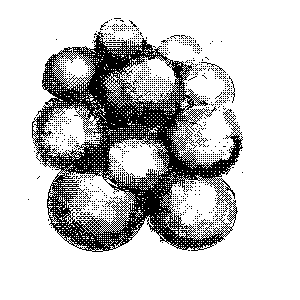
same as below but set at 20 frames per second. on my PC Firefox plays it at 20 but IE won't play any GIF above 10.
Same GIF at 580 pixels square (265 KB--each GIF frame is 580 X 580, it's not just scaled up in html)
...and 580 pixels square, 10 frames per sec (also 265 KB--not quite ready to exceed 100KB on the main blog page yet).
any comments on the relative success or failure of these different sizes and speeds would be appreciated. I'm trying to get some "optimum" standards across browsers and machines.
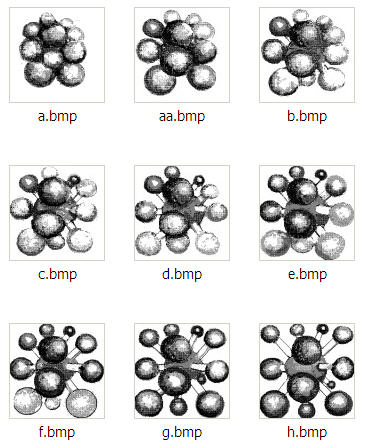




"3 Boxes" GIF by Jack Masters or Kasey Kite X 4 (repost)
Radio interview here with Seymour Hersh about his New Yorker revelations that the US and Saudis are funding al Qaeda, the group that attacked the US on 9/11, as a supposed check on Iran, which the US foolishly empowered by invading Iraq in '03. The Sunni jihadis are already setting up shop in Lebanon to combat Hezbollah. Elliott Abrams, the same person who brought you "selling arms to the Iranians to fund the Nicaraguan contras" in the '80s, is behind this cynical mess of a policy. And President Cheney, of course. Will Congress stop the treachery?
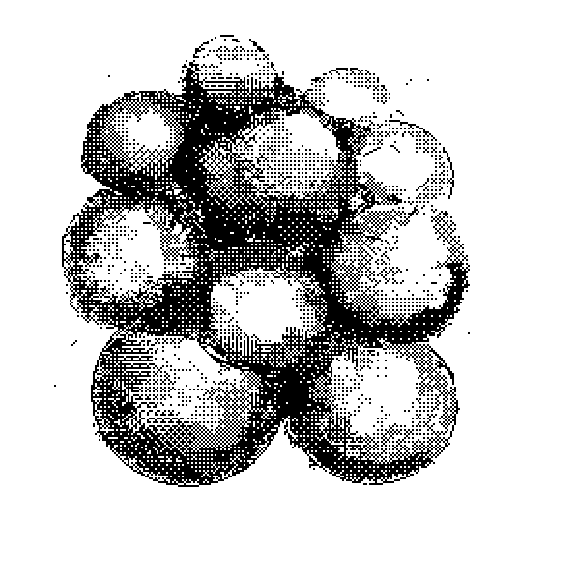
Paddy Johnson on the one art fair this blog would have attended if it had known about it: the Comic-Con, at the Javits Center.
This preference is not because of some chip-on-the-shoulder resentment about the high-falutin' art world so much as a standing revulsion to the idea of having fairs in a city with the largest year-round real estate commitment to art. Every year dealers take work from where it looks the best, bubble wrap it, and schlepp it over to where it looks the worst. All for the convenience of a few uber-mavens who don't want to walk around Chelsea (one supposes). That, and the ultra-distilled odor of commerce that wafts over all fairs, makes it just too depressing for this sensitive artist.
Just checking out Contemporary Home Computing, a webzine by Olia Lialina and Dragan Espenschied, with articles and blogs about our favorite appliance, its metaphors, and its place (or willed absence) in the culture at large. The perspective here is low-res and retro (in a good, non-Ludditic way). Sample article: Espenschied's Where did the computer go?, considering the drive to dematerialize hard drives and screens in the home and workplace, bringing us closer to the Platonic ideal of data as pure light and air. Kind of like factory farming, where meat magically appears in stores in shrink-wrapped cubes and the slaughter and biochemistry takes place somewhere else.
